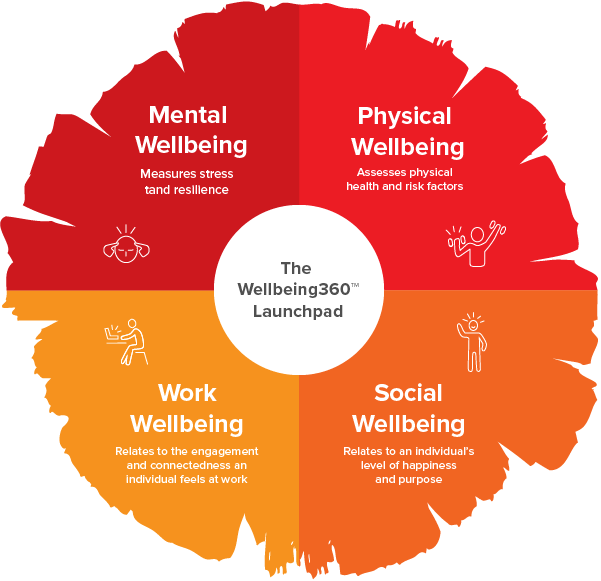Work wellbeing is one of the quadrants that make up whole-person health. It’s an area that can often be overlooked by business leaders. Work wellbeing is your employees level of engagement and connectedness in the workplace.
We spend up to 80,000 hours of our lives at work. And in a world where bottom-line results are crucial for businesses, paying attention to your team’s workplace wellbeing isn’t something you do only when you have extra time on your hands.
Employee engagement and connectedness are the outcomes of good company culture, and good company culture supports work wellbeing.
- Do you employees have a good work-life balance?
- Is your workplace enabling employees to do their best work?
- What is the return on investment in improving the wellbeing of your employees?
The Unthinkable: Losing Your Star Employees
Not only does poor work wellbeing equate to detached and disengaged employees, it also equates to poor employee retention rates. An issue that is compounded in this war for top talent. Lack of engagement and connectedness are some of the biggest reasons as to why your best employees are thinking of jumping ship.
Managers usually focus their attention on the underperformers and often leave the A-players hanging. But the truth is, your superstars need as much attention as everyone else.
Take a close look at your own team. Are your top performers satisfied with their jobs?
Before you confidently answer in the affirmative, check out the results from SAP and Oxford Economics’s study: 20% of top-performing employees are planning to quit their jobs in the next six months.
That’s one in every five employees.
As you may already know, top performers are hard to replace. It hurts. More than a toothache. And it’s not just because they are known to deliver 400% more in productivity compared to the average; it’s also because replacing them will cost you up to twice their annual salary.
This is why work wellbeing has become every great manager’s focus. And we can’t blame them for their enthusiasm. We’ve seen what it’s like when teams are motivated and energised and happy. The results speak for itself.
Why Your Employees’ Workplace Wellbeing Should Be Your Top Priority
Workplace wellbeing at its purest sense is about helping employees feel good and safe at work. Over the years, more companies have seen the upside of investing in promoting their employees’ wellbeing in the workplace simply because they’ve seen the positive results.
Researchers at University of Warwick found that happy and contented employees are 12% more productive; they are also found to be more creative and effective at problem-solving.
Dr Amanda Allisey of Deakin Business School’s Department of Management specialises on improving mental health and wellbeing in the workplace. What she said encompasses everything we believe about wellbeing:
“When employees enjoy a happy, healthy work environment, you start seeing exciting innovations in business. It’s the difference between an organisation that’s simply functioning and an organisation that’s capable of making huge leaps. It really comes down to the people who are working within it.”
Happy and healthy employees feel a sense of purpose and fulfilment. Because of the supportive nature of their work environment, they are more engaged and committed to do their jobs well.
They are more capable of handling stressful situations and meeting client demands. Because they feel safe and know that their managers care about their wellbeing, they’re more likely to stay longer in the business rather than jump ship at the sight of another opportunity.
Simply put, when your employees see that they are supported and appreciated, your business is well on its way towards enjoying long-term profitability.
Actionable Strategies to Increase Work Wellbeing
Is your business ready to take one giant leap? Here are some ways to start.
1. Have regular one-on-ones.
If you have a calendar system, prebook 30 minutes of your time to chat with each member of your team. This gives you the chance to ask them about their day and encourages them to open up to you about any issue affecting their productivity.
2. Recognise and reward employees.
Whether it’s a free movie ticket or sponsoring a fancy dinner for two, recognition and rewards engage employees, increase loyalty, and contribute to better business results in the long run. Rewarding your best talent shows that you have a supportive work environment and thus helps retain them.
3. Conduct personal progress plans.
At least every six months, you or your managers should sit down with each team member and plan their growth with them. It’s the best time to identify strengths, address weaknesses, and determine how they want to grow in their career and how the company can help them achieve that.
4. Identify training and development opportunities.
The competition to acquire the best talent is getting tougher. One of the ways to acquire and retain them is by showing that you care about their growth by allowing them to attend trainings or seminars that will further shape their career.
5. Provide a clear career path for progression.
The lack of career advancement is one of the main reasons employees seek for new jobs. Businesses who were successful in maintaining their best employees are most likely to have amazing career development programs.
6. Healthy and flexible work hours.
As managers, it’s your responsibility to encourage work-life balance: Don’t set a bad example of working late. Don’t let your team overwork themselves. Oftentimes, we have important commitments outside of work; consider offering flexible work hours to accommodate instances like this.
7. Show employees how their work contributes to the success of the business.
Employees greatly appreciate it when you let them know why their work matters. This motivates them to think independently, stop second-guessing, and own their work.
8. Foster team relationships.
Positive relationships in the workplace greatly affect how teams work to accomplish tasks. Always set time for instances to connect with your team or to participate in fun team-building activities.
The Key to a Happier Workplace for a Healthier Business
These best practices are pretty standard for any business today. And often they end up becoming a box-ticking exercise. Looking after your employees’ wellbeing is a key factor to ensure your organisation’s long-term effectiveness. Employers today are expected to support and nurture workplace wellbeing. And workplace wellbeing is just one aspect of a healthy business.
If you want to truly make a difference in the lives of your employees, it’s time to look at wellbeing as a whole and through a bigger angle. You need to look at four quadrants – mental, physical, work and social – so you can confidently assess your employees’ health, happiness, and productivity. The Wellbeing360 Launchpad is an assessment tool that gives you an idea of what areas need work and what areas you’re best in. This tool gives you reliable data to shape and drive your People and Culture strategy. It not only provides you with reliable metrics and insights, it is a customisable platform that deploys behaviour change programs.
At Vitality Works, we help businesses like yours identify the areas you need to focus on, so you can help your employees perform their best. We developed a whole health system that will help revitalise all four quadrants of your employees’ personal health. Contact Vitality Works today to find out more about the Wellbeing360 Launchpad.
Find ‘The ultimate guide to improving the mental wellbeing of your employees in the workplace’ here
Find out ‘How to improve the physical wellbeing of your employees’ here
Find out ‘The truth about social wellbeing at work’ here
Learn more about Wellbeing360, the health and wellbeing launch pad


